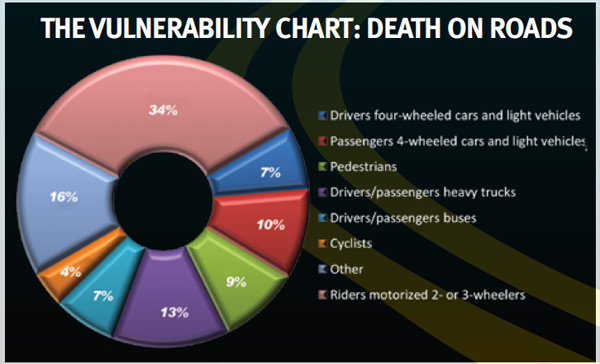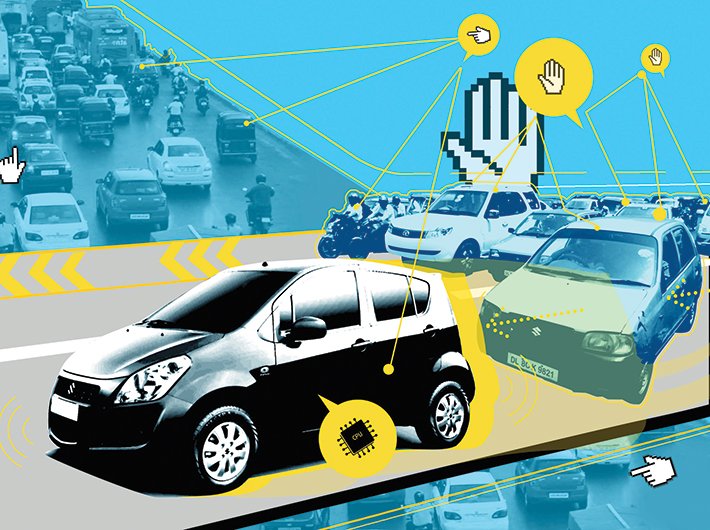While technology is a key backbone of any modern traffic management system, simple commonsensical non-technology interventions affecting road user behaviour cannot be ignored either
The IT taskforce, set up by the ministry of road transport and highways, has been on its toes over the last six months. While the 10-member committee crisscrossed the country, visiting major cities and ports, meeting experts and citizen groups, it launched a nationwide initiative, #ITForParivahan, for inviting suggestions from various stakeholders in transportation sector and public at large.
Also read: Traffic travails: Deadlock in Delhi and NCR
The call for ICT intervention to modernise the commutation in the country does not come as a surprise, even though commonsensical, basic things have often been ignored by the authorities and the town planners, as also by the commuters themselves causing chaos on the road, and hampering the critical safety parameters.
While increasing road congestion and vehicular pollution is a matter of concern, road accident deaths is another big issue that is worrying the authorities. According to the data available with the ministry of road transport and highways, almost 1,39,671 people lost their lives on India’s roads during 2014. This translates to over 382 deaths every day due to road accidents or related incidents. It is more than four times the annual death toll from any act of terrorism in the country. Of these, over 57,844 people lost their lives in 2014 due to over-speeding, while 6,968 people died in accidents because of drunken driving.
Loads of wheel
Total registered vehicles for 2012
15,94,90,578
Four-wheelers light vehicles
3,83,38,015
Two and three-wheelers 11,54,19,175
Heavy trucks 40,56,885
Buses 16,76,503
The recent WHO global road safety report too indicates that India stands out miserably on the road safety front. The report points out that users of two-wheeler and cycles, and pedestrians are among the most vulnerable groups and amount to nearly half of all road accident deaths world over. It also points out that India has no laws protecting pedestrians and cyclists who account for more than one-third of all road accident deaths in the country.
The report highlights that the world’s 10 most populous countries, including India at #2 position that account for almost 4.2 billion people and 56 percent of the world’s road traffic deaths (7,03,000) – do not have sufficient laws on key five risk factors as identified by the global health body and other agencies as best practice. These include legislation to control speed, drunken driving, use of helmets and seat-belts and laws to restrain driving by children. While Brazil tops the list of legal provisions for four of these, except speed driving, India has so far managed to make only seat belts mandatory for car drivers.
Technology or common sense
For a country like India which is going full throttle ahead on technology (read information and communication technology), it is but natural for its ministries to talk of ‘Digital India’ and ‘Smart Cities’. And while there is no denying that ICT is fast emerging as the core backbone of anything and everything that impacts our lives, the importance of common sense and good behaviour cannot be substituted by any technology.
While technology can help the city provide synchronised traffic signals that can automatically detect the traffic load and decide on the duration to switch from stop signal to green light, it cannot stop the drivers from jumping red lights or force drivers to follow lanes or wear helmets. This, however, can be enforced by adopting and effectively implementing adequate laws. “Changing road user behaviour is a critical component of the holistic safe systems approach that the cities need to adopt good laws to enforce change in road user behaviour on key risk factors for road traffic injuries – speed, drink-driving, and the failure to use helmets, seat-belts and child restraints properly or at all,” advocates the WHO report.
It is also important that the town planners and authorities create infrastructure with common sense and with citizen in view. A good example of bad planning is the execution of Delhi Metro that has encroached upon several pavements to construct stairs for its stations, completely unmindful of the needs of a wheelchair-bound person or those with visual impairment, not to talk about a normal pedestrian. The lack of safe right of way on the pavements not only causes inconvenience but also exposes them to road accidents. The municipal corporations have also left no stone unturned in encroaching the pavement to create urinals and garbage bins.
The report further highlights the important role of safe infrastructure and safe vehicles in reducing road traffic injuries. Road infrastructure is mainly constructed with the needs of motorists in mind, although the report indicates that 49 percent of all road traffic deaths occur among pedestrians, cyclists and motorcyclists. This is an area that does not require much technological interventions. Similarly, roads and related infrastructures also need to be built for the needs of physically challenged, children, senior citizens and expecting mothers.

“Real, sustained successes at reducing global road traffic deaths will only happen when road design takes into consideration the needs of all road users,” the report states adding that while vehicles in high-income countries are increasingly safe, less than half of countries implement minimum standards on vehicle safety. These standards are absent in many of the large middle income countries, like India, that are major car manufacturers.
The WHO report estimates that over five lakh lives could be saved each year in developing countries by creating an efficient emergency system to tackle road accident casualties. While India boasts of a multiple access numbers for emergencies, only a few are reliable, compared to 116 countries that have a universal access number to activate emergency services response.
“If these countries (including India) were all to bring their road safety laws in line with best practice, and adequately enforce them, there would be huge potential to save lives and reduce injuries resulting from road traffic crashes. Furthermore, this would go a long way towards reaching the target reduction in road traffic deaths identified in the sustainable development goals,” the report points out.
IT for road safety
The first important thing is the readiness of vehicles and the road infrastructure and ICT-enablement or making them ready for one-to-one, one-to-many and many-to-many interaction. An important part of this is the bandwidth, or the national information super highway. A lot can be done on this front by the ministry of road transport and highways by providing right of way (ROW) to the telecom service providers for laying out the essential fibre optic network along the national highways. A similar model can be followed by giving the ROW along the state highways and other roads with a rider that the service provider will provide free Wi-Fi and the connectivity for emergency services along the road for which they get the ROW.
The next in line is to make the vehicles ready for machine-to-machine (m-2-m) communications. This will not only help make the vehicles safer, it will also help enforce certain rules and regulations, as well as improve disaster response time. According to experts, the cost of making a car ready for such m-2-m communications at the OEM level should be around Rs 5,000, which is not a big amount and users will be ready to pay it if it helps decongest roads, improve travel safety and helps them save travel time.
This means that automobiles sold in India will have sensors on board that can help them interact with the city and transport infrastructure for a two-way communication. The benefits could be many. On the other hand sensors on the roads can monitor the build-up of congestions and wirelessly send this information to a central traffic control system that can then automatically imposes variable speed limits to streamline the flow of traffic in a particular area.
This central traffic control system could then send an alert to the car, using, for example, solutions like Microsoft Sync that connects through the driver’s mobile network to inform them about the routes to avoid or those that are clogged. Ford, for instance, is already shipping passenger cars in India that have Microsoft Sync features, including the ability to connect to the 911-type emergency assistance number for help in case of an accident. In fact, the software enables the vehicle to automatically connect the number without intermediary assistance.
On board computers can also serve as speed governors, particularly in school buses or in controlling the often over-speeding trucks and private buses, imposing maximum speeds on the vehicle by controlling the brakes and the engine. While the concept may sound futuristic, Google is already developing a computer-driven car, which uses cameras, radar, and range finders to detect obstacles and other vehicles. The Google smart car has been extensively tested on public highways and smart roads lined with sensors, including that on Britain’s A14 highway (see box), which the country is converting into the first connected road infrastructure.
These sensors can also help keep an eye on the vehicular health, and thereby help reduce pollution caused by vehicular emissions. While the centre and the Delhi government have pleaded before the National Green Tribunal (NGT) that the health of vehicle, and not its age should be considered for deciding when to scrap a particular vehicle, the Internet of Things allows the authorities to exactly manage what they want NGT to allow.
The sensors can automatically intimate the city control centre about the quality of emission by each vehicle and the overlaying layer of data analytics software can flag the vehicles breaching the pollution norms, and alert the nearby traffic control rooms or traffic control vehicles, can complete with the details of possible routes that the vehicle might take and its registration number, make and colour for easy identification. An automatic challan can also be issued with an order to get the vehicle rectified and a date for the vehicle inspection. In case the owner fails to get pollution under control certificate within the stipulated deadline, the vehicle’s registration can be temporarily suspended. It can be permanently suspended after another warning and an opportunity to get it certified.
While Gurgaon has already decided to go ahead with the car free Tuesday and with the Delhi government also piloting the initiative with car-free day on every 22nd of the month on certain roads, leaving the monitoring entirely on the already thin traffic police team makes the task, if not impossible, a daunting one. The technology cannot just monitor and impose scheduled restrictions on vehicular movement but can also help identify the violators and automatically issue warrants or challan to them. The same technology can be used to implement paid and free roads, as in Singapore, including variable rates for peak and non-peak hours.
Each vehicle can have a contactless pre-paid card and the toll or road fee can automatically get deducted the moment it enters a particular zone, based on the pre-determined structure. In case the card is out of cash, the traffic control system can intimate the vehicle owner on the registered mobile number and also by flashing a message on the on-board message screen. The owner can then get the card re-loaded. Alternatively, a monthly road usage bill can also be sent to the registered address.
With the country now switching over to the smart card based driving licence (DL), the ministry should also seriously consider making the maximum use of the identification document to verify the identity of the driver of a particular car. The cars can have additional features that will allow only registered DLs to be used as a second factor authentication key to start a car. This means that the bonafide user will have to register the DL with the car’s system using the car’s registration certificate (RC) smart card and the one time password (OTP) that can be sent on the registered user’s mobile phone. Hence, one will now need to place the DL in the slot in a car and authenticate to start the vehicle.
While this will help avoid situation of establishing driver’s identity, like in the case of the accident involving Salman Khan, it will also nearly put a clamp on car theft. Besides, the challan for violation can now be issued in the name of the driver and against the particular DL number, instead of the vehicle and the RC number.
There is also a need to use technology to make the road infrastructure friendly particularly the disabled, elderly, children and expecting mothers. While tactile tiles are an important part of road signage for the visually challenged it will be a great idea to install hooters with different, but standard sound, for red, yellow and green signals. This should be synched with the traffic light management system and the sensors at both ends of the road and under the zebra crossing to detect the movement.
The sensors under the stop line can also ensure that the cameras at the traffic signal get activated based on certain pressure (of vehicular weight) to capture the registration number of vehicles that jump red light. The sensors beneath the roads can also detect the road stress level and communicate it to the maintenance division, which can run the data past the set parameters to identify the road condition. Measures like these can certainly help enforce the road safety rules and the existing Motor Vehicle Act in the country.
While reports indicate that the #ITForParivahan Challenge has received over 35,000 suggestions, it is important that the report submitted by the taskforce does not explore the solution to India’s road safety woes by putting technology first. The right approach will be to put the problems and citizen in front and explore non-technology options first. Technology interventions can but only serve as the means to better implementation of the means to these solutions. The interventions along with the proposed road safety bill will make sure that the union road, transport and highways minister will not need to say “sorry” for high number of road accidents in the country again. n
parth@governancenow.com

